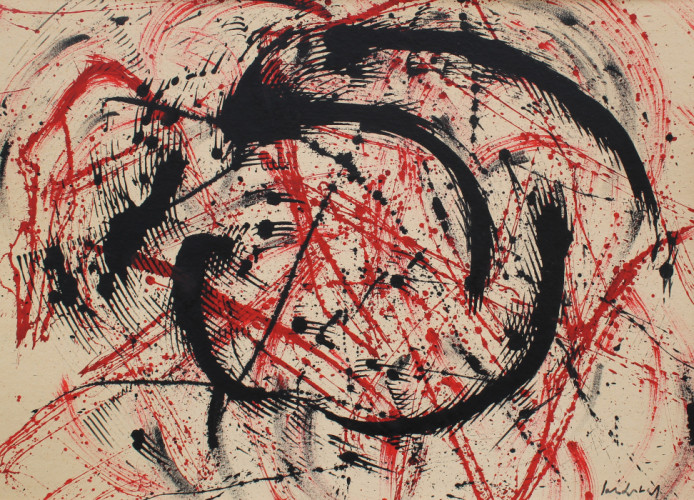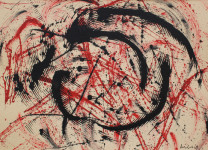Kurt Rudolf Hoffmann KRH Sonderborg Dynamic composition
Price:
On request
Product details
| Product number: | 1172 |
| Artist: | Kurt Rudolf Hoffmann KRH Sonderborg 1923-2008 |
| Style: | Informal |
| Material: | Acrylic |
| Dimensions: | 50 x 70 cm |
Product description
Dynamic composition from the late 90s by the informal artist Kurt Rudolf Hoffmann Sonderborg.
K.R.H. Sonderborg, actually Kurt Rudolf Hoffmann, was an important German painter who is considered one of the most important representatives of abstract painting and Informel. He was born on April 5, 1923 in Sønderborg, Denmark and is best known for his expressive-abstract painting style. Sonderborg was a free-spirited artist who often went against conventional and academic structures in his work.
Early life and political resistance:
Sonderborg grew up in Hamburg and was disabled - he had no right hand. As a teenager, he came into conflict with National Socialism because of his membership in the “Swingjugend,” a group of young people that the Nazi government considered “degenerate.” In 1941 he was arrested by the Gestapo and imprisoned in the Fuhlsbüttel concentration camp because he was suspected of falling under Anglo-American influences and acting against the regime. This experience had a lasting impact on him and influenced both his political consciousness and his artistic vision.
Artistic development:
After the Second World War, Sonderborg increasingly turned to painting. He initially took private painting lessons and later studied at the State Art School in Hamburg. However, he found the academic training restrictive and soon followed his own, unconventional artistic vision. From the 1950s he was active in the Hamburg art scene and became a member of the artist group ZEN 49, which promoted abstract painting.
Influences and way of working:
K.R.H. Sonderborg was strongly influenced by the American art scene, especially action painting, but did not fit into any of the established art movements. He himself always questioned the classification of his work as informal and preferred to be perceived as a free, independent artist. His work was characterized by expressive and gestural painting, which often did not contain any obvious depiction or figurative elements.
Sonderborg often worked without a fixed studio and painted in changing environments, which earned him the nickname “painter without a studio”. Despite this independence and his often unconventional approach, he achieved international reputation.
Awards and Recognition:
K.R.H. Sonderborg has received many awards for his artistic work, including the Grand International Prize for Drawing at the São Paulo Biennale (1963) and the Hans Molfenter Prize of the City of Stuttgart (1987). He took part twice in the Documenta in Kassel (1959 and 1964), one of the most important exhibitions of contemporary art.
Heritage:
K.R.H. Sonderborg is considered one of the outstanding German artists of the 20th century and left behind an extensive body of work that is still valued today in both museums and private collections worldwide. His influence on abstract painting and informal art is still felt today. Sonderborg died in Hamburg in 2008, but his art remains an important part of modern art history.
K.R.H. Sonderborg, actually Kurt Rudolf Hoffmann, was an important German painter who is considered one of the most important representatives of abstract painting and Informel. He was born on April 5, 1923 in Sønderborg, Denmark and is best known for his expressive-abstract painting style. Sonderborg was a free-spirited artist who often went against conventional and academic structures in his work.
Early life and political resistance:
Sonderborg grew up in Hamburg and was disabled - he had no right hand. As a teenager, he came into conflict with National Socialism because of his membership in the “Swingjugend,” a group of young people that the Nazi government considered “degenerate.” In 1941 he was arrested by the Gestapo and imprisoned in the Fuhlsbüttel concentration camp because he was suspected of falling under Anglo-American influences and acting against the regime. This experience had a lasting impact on him and influenced both his political consciousness and his artistic vision.
Artistic development:
After the Second World War, Sonderborg increasingly turned to painting. He initially took private painting lessons and later studied at the State Art School in Hamburg. However, he found the academic training restrictive and soon followed his own, unconventional artistic vision. From the 1950s he was active in the Hamburg art scene and became a member of the artist group ZEN 49, which promoted abstract painting.
Influences and way of working:
K.R.H. Sonderborg was strongly influenced by the American art scene, especially action painting, but did not fit into any of the established art movements. He himself always questioned the classification of his work as informal and preferred to be perceived as a free, independent artist. His work was characterized by expressive and gestural painting, which often did not contain any obvious depiction or figurative elements.
Sonderborg often worked without a fixed studio and painted in changing environments, which earned him the nickname “painter without a studio”. Despite this independence and his often unconventional approach, he achieved international reputation.
Awards and Recognition:
K.R.H. Sonderborg has received many awards for his artistic work, including the Grand International Prize for Drawing at the São Paulo Biennale (1963) and the Hans Molfenter Prize of the City of Stuttgart (1987). He took part twice in the Documenta in Kassel (1959 and 1964), one of the most important exhibitions of contemporary art.
Heritage:
K.R.H. Sonderborg is considered one of the outstanding German artists of the 20th century and left behind an extensive body of work that is still valued today in both museums and private collections worldwide. His influence on abstract painting and informal art is still felt today. Sonderborg died in Hamburg in 2008, but his art remains an important part of modern art history.


